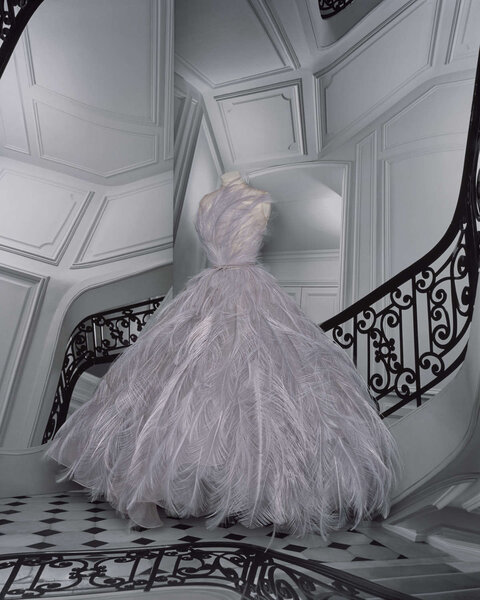The fantasy of fashion (and its shortcomings) in Le Mythe Dior

At the start of 2020, Christian Dior unveiled a utopian vision that asked, "What if women ruled the world?" Cut to six months later, Couture Week has switched from packed Parisian locations bustling with models, designers, and attendees to an online format. All industries are adapting to the current conditions as a result of the global pandemic, which includes scheduled events like Fashion Week. Plans are set in motion for Paris Fashion Week to go ahead in September, however, summer runway presentations have shifted to digital in response to social distancing restrictions.
Drawing on the history of the brand combined with fairy tale storytelling in Le Mythe Dior, the Fall 2020 Dior haute couture collection is an escapist vision that leans into the fantastical elements of high-fashion. All while paying homage to the expert craftsmanship that goes into each stitch.
"Surrealist images make visible what is itself invisible. I am interested in mystery and magic, which are a way of exorcising uncertainty about the future," Dior artistic director Maria Grazia explains in a statement discussing the concept and how the current COVID-19 situation informed the work. The notion of an uncertain future is very much on everyone's minds at the moment and we look to art and culture as a means of escape whether the stories we consume or the clothes we dream of wearing.
Feminist art by Judy Chicago played a vital role in the last collection, now Grazia has looked to surrealist artists Leonora Carrington, Lee Miller, Dora Maar, and Jacqueline Lamba for inspiration. "Alchemy is a form of magic, so the transformation of images, or bodies, in art acts on dream/psychic substance" is a quote by Carrington chosen by Grazia, which further underscores the theme of the dreamscape in this couture show — even if it eschews the typical format of Couture Week.
Turning to another time of upheaval, Grazia switched the runway for miniature mannequins to model the garments. In 1945 post-liberation France, materials were still scarce so French designers including Christian Dior resorted to a scaled-down version for a touring exhibition to raise funds for survivors and the industry.
Called the Théâtre de la Mode (Theater of Fashion), over 60 artists — including couturiers, milliners, and jewelers — took part in the morale (and finance) boosting exhibition that ran for a year. In the present day, a trunk built to look like 30 Avenue Montaigne in Paris (aka the iconic fashion house address) will transport the miniatures as it embarks on a world tour.
Sprinkling sartorial magic into this concept are the expert in-house design team that hand-made each scaled-down garment to resemble the full-size number — this fascinating behind-the-scenes video reveals some of the techniques. Draping, embroidering, and pleating delicate fabrics require "fairy fingers" as one of the team notes.
Accompanying the images of the 37-item collection is an ethereal 10-minute short film shot by Italian director Matteo Garrone, whose fairy tale credentials include last year's Pinocchio. Weaving together the intricate craftsmanship that goes into each garment by revealing the experienced artisans who work in the atelier before transporting the viewer to the enchanted setting doesn't negate the fantasy. Instead, the peek behind the couture curtain adds to the awe of those who work behind the seams (pun intended).
Revealing the experts behind the clothing before seeing the woodland nymphs and mermaids pays homage to those that bring the fantasy of high-fashion to life. Ball gowns fit for the red carpet (when it returns) showcase the Dior signature silhouette while also drawing on the Grazia approved Greco-Roman influence. So many capes to dramatically swish or make a powerful exit.
Taking on the quality of a fairy tale, Le Mythe Dior shifts from the workspace to the green Garden of Ninfa paradise. In reality, it is an Italian natural monument near Rome built in the 20th century, incorporating the ruins of the medieval city of Ninfa. This is a settlement that is said to take its name from the temple dedicated to the Naiad Nymphs aka goddesses of spring water.
It is easy to see why this dreamy garden was picked to showcase a collection attuned to nature when the runway is out of commission.
The sun-drenched location features the ornate trunk of gowns resembling the Dior fashion house going on tour. Instead of cities, women residing in streams, shells, and forests are the customer du jour. The delivery method of these gowns via miniature dolls is how the collection will be presented to clients across the globe (but without the horny faun to look on in wonder at the tiered ruffled tulle cape his beau has chosen).
In a world of tree nymphs having their measurements taken for a gown (after they have finished hooking up in a tree trunk) and a mermaid swimming while wearing couture, the brand falls short with the diversity of casting in its depiction of the escapist fantasy. As with the previous collection, only women of a runway size are invited to this particular gathering. Disappointingly, in this ethereal vision, there are no models of color — Diet Prada pointed out the last Dior couture show featured over 30 percent models of color.
Greek myth provides the foundation, but that is far from a viable reason for the casting choices. Offering an uplifting vision within an escapist fantasy setting while paying homage to the Dior artisans and using similar methods after WWII is notable, but the spell is broken by the lack of diversity.



















